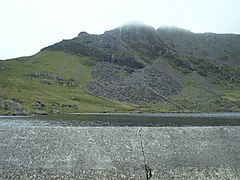Moelwyn Slate Quarry
| Moelwyn Slate Quarry | |
|---|---|

The Moelwyn Slate Quarry, viewed from across Llyn Stwlan
|
|
|
|
|
| OS grid reference | SH661442 |
| Coordinates | 52°58′44″N 3°59′42″W / 52.9788°N 3.9950°WCoordinates: 52°58′44″N 3°59′42″W / 52.9788°N 3.9950°W |
Moelwyn Slate Quarry is a defunct slate quarry located to the south of the village of Tanygrisiau, north Wales. Some initial prospecting was carried out in the 1820s and again in the 1840s, but it was 1860 before a company was formed, and chambers were excavated. The quarry was never a financial success, and operated sporadically until its demise in 1897. Despite the poor results, a spectacular series of seven inclines were constructed, to enable slates to reach the Ffestiniog Railway. The quarry was hampered by lack of a good water supply, and the mill was constructed between inclines 4 and 5, where water could be obtained from Llyn Stwlan. As in many quarries, barracks were provided, but these were occupied by whole families, living on the mountain, rather than used as lodgings for the quarrymen during the working week. Even in its remote location, there was still a concern for education, with basic literacy classes being run in the 1860s.
Between 1826 and 1828 the Rothschild's Royal Cambrian Company attempted to locate commercially viable slate deposits on land belonging to the Crown, on the eastern slopes of Moelwyn Bach. Considerable effort was expended, as Nathan Meyer Rothschild employed John Rogers from Wrexham to construct a cart road, which wound its way up the side of the valley to reach the quarry. It was known as Ffordd yr luddew mawr ('road of the great Jew'), and was extended around the western flanks of Moelwyn Mawr in the 1850s to reach Pant Mawr Quarry. Several small-scale trial levels were cut, but none proved profitable, and Rothschild withdrew in 1828. Attention then switched to the southern flanks of Moelwyn Mawr, where a lawyer from Ruthin called Humprhey Jones had opened a quarry by 1841, but activity at the site was very intermittent.
The next major advance was in 1860, when the Great Moelwyn Slate Company Ltd. was founded and paid £9,890 to buy the quarry from Thomas Cooper Smith. Chambers were excavated underground, but as there was no reliable source of water to provide power, the mill was built at some distance from the workings, and at a lower level, so that a 40-by-4-foot (12.2 by 1.2 m) waterwheel could be fed from Llyn Stwlan. This drove six sawing tables and seven dressing machines. Three barrack buildings were erected, and whereas at most quarries, these were provided for the workers, at Moelwyn they were occupied by whole families, who lived there, rather than lodged there during the working week. The children had to make an arduous treck along the cart road to Tanygrisiau to attend school. The slate quarries were known as places of learning and culture, with barracks at many quarries including reading rooms or libraries, which were regularly updated with Welsh language newspapers and magazines produced by the non-conformist denominational churches. Even in its remote location, Moelwyn was no exception, as basic literacy classes were taking place there in the 1860s when it was visited by Lord Palmerston.
...
Wikipedia

